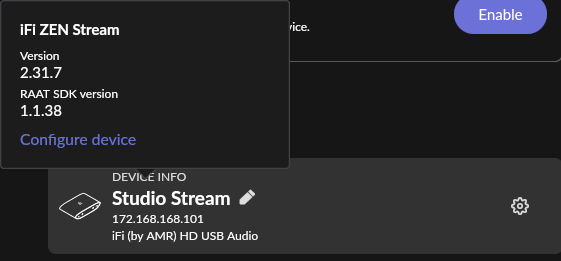2.31.11 is now out, I installed it this afternoon.
Just go to iFi.local/dev and enable the beta update there
yes, I think 2.31.7 was the last non beta… I just updated to 2.31.11 and cannot check out anymore
Edit:
I found a screen with the last non beta firmware

I installed the beta version also. Probably nothing major has been changed since 2.31.7 since the version number is still 2.31. I couldn’t find the change log.
@Michael_Harris and @Traian_Boldea - This thread wasn’t just a demonstration of your technical and iFi prowess, it was a demonstration of how nice you guys are to spend your New Years Eve helping someone get up and running. Happy New Year to you and your families!
I think it was a one liner about incompatible something or other. Minor version update as you said
Just characters we play on the Forum’s ![]()
Happy new year to you and yours as well
And thank you for your kind words
you are very kind.
happy 2023 to you too
Well, you picked nice characters from among a broad set of alternatives ![]()
Thank you, you are very kind as well.
We sort of can’t help ourselves is closer to the truth and I am guessing that @Traian_Boldea would probably agree with that statement as well.
At the end of the day that’s what this community is all about
100% agree
I’m already in 2023, Happy New Year
Well you got there before me at least ![]()
Have a great night and year ![]()
![]()
A comment on resampling: Doesn’t any DAC with ASRC resample the incoming audio stream?
It was my understanding that whether your USB input to the DAC was asynchronous or not, if your DAC has ASRC on that input, the digits are Re-Re-sampled prior to D-A conversion.
ASRC is popular with DAC makers, as I understand it, because EVERY digital input to the DAC-device can be run through the ASRC chip, thus eliminating ALL jitter and synchronizing the clocking between the ASRC-chip and the DAC-chip.
IF ASRC is resampling anyway, (and I admit that I may not understand this correctly), then what difference would it make if an upstream device (such as Apple TV) is also resampling? In other words if your HD feed is being down-rezzed by the ASRC…
No that is what bit perfect is all about, keeping the chain of music the same all the way down the line.
Android’s Audio stack convert’s everything to 24/48 as does the Apple TV through HDMI.
Roon and HQPlayer both have heavy duty tools to upscale in high quality mode which is quite different to what happens on the Android/Apple TV side.
But it is all fairly marginal in terms of sound quality
What happens inside the DAC is not part of the transport anymore, it’s just an implementation detail of the D/A process, so bit-perfectness doesn’t apply. For example, in sigma-delta DACs, the signal is resampled to say 256fs and reduced to say 6 bits before the actual D/A.
DACs using “async” USB don’t need ASRC since the USB rate can be changed dynamically; they only need “sync” rate conversion.
Thanks Marian I think we were having a different conversation ![]()
Oh, I thought it was about ASRC, which is part of the DAC internals.
No sorry I was having a different conversation, my bad.
Too much alcohol meaning I didn’t read what @Glenn_Young wrote and I assumed what he was saying was something else ![]()
No worries. We haven’t started the party in the PST time zone yet.
I still do not fully get it. But that is ok ![]()
Can be asynchronous and also ASRC?
Found this on USB transfers (skipped one):
Adaptive
The destination device has a local clock, adjusted according to the average rate of the incoming data stream
- − Less susceptible to jitter than Synchronous, but still not fully stable
- − Synchronization and stabilization often results in large initial latency
A variation on Adaptive uses a destination fixed local clock and an Audio Sample Rate Converter (ASRC) to match the rates of the arriving data stream to the local DAC
Asynchronous (Acknowledged as the most reliable and desirable implementation)
- The destination device has a local clock
- The destination device has a receive buffer and signals the source to adjust the rate of data delivery according to the amount of data available in the buffer
- − No jitter, as stable as the local clock
- − Low latency (the receive buffer can be kept small)
Most DACs today use the async mode, where the device clock is used exclusively for D/A and the transfer rate is adjusted to avoid buffer underflow and overflow. My point was that you don’t need ASRC in this mode. The internal up-sampling can be synchronous, i.e. fixed rate.